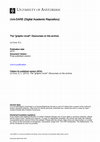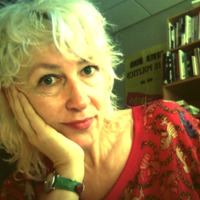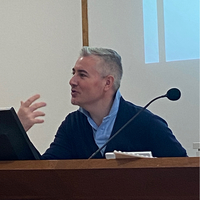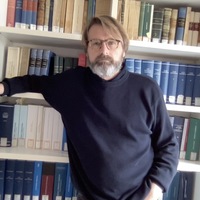Articles by Erin La Cour
Introduction to the thematic cluster of Image[&]Narrative 17.4
Edited Anthologies and Journals by Erin La Cour
Conference Organization by Erin La Cour
Master class open to: RMa students who are a member of a Dutch Graduate Research School (onderzoe... more Master class open to: RMa students who are a member of a Dutch Graduate Research School (onderzoekschool). RMa students who are members of OSL will have first access. RMa Students will receive 1 EC for attending the full day and preparing an object of inquiry for the master class.

Amsterdam Comics is pleased to announce our inaugural international conference, “Comics Interacti... more Amsterdam Comics is pleased to announce our inaugural international conference, “Comics Interaction,” which will take place from 1-3 July in Amsterdam, Netherlands. Comprised of three days of parallel panel sessions, round table discussions, and public keynote lectures, the conference aims to encourage interdisciplinary connections between comics scholars from various disciplines, comics artists, publishers, and cultural workers from museums and other heritage sites. The conference will focus on three themes of comics interaction: Comics in Art, Art in Comics; History and Trauma in Comics; and Comics as World Literature. The conference will be hosted at the University of Amsterdam and several local cultural institutions.
Keynote Speakers:
Prof. Dr. Jan Baetens, University of Leuven, Belgium
Prof. Dr. Bart Beaty, University of Calgary, Canada
Dr. Joyce Goggin, University of Amsterdam, Netherlands
Application:
Applicants to the conference are invited to submit a 250 word abstract, short biographical note, and indication of theme preference by 17 April 2015 to the organizers, drs. Rik Spanjers and Dr. Erin La Cour, at info@amsterdamcomics.com.
For more information about the conference themes see PDF-file.
Papers by Erin La Cour

PhDs have proven inspirational and thought-provoking, consistently challenging and encouraging. B... more PhDs have proven inspirational and thought-provoking, consistently challenging and encouraging. But, more than this, so many have proven to be dear friends. Thank you especially to Pepita and Aylin for being my paranymphs and to Anik for being my honorary paranymph. You three have been there from the start, and I'm so happy to have you stand beside me now. Thanks, too, to all you other lovely ASCA people who've made this experience a million times better-Adam, Birkan, Melanie, Margaret, Hanneke, Niall, Lara, and Thijs. I am also grateful for the new friends and colleagues I've made in Copenhagen. Thanks especially to Rikke for endless discussions about comics, and more importantly, for solidarity and many fun times in Copenhagen. To Anne Magnussen for being a great advocate and inspiration. To Lucian, Mathias, Frauke, and Peter for great camaraderie. To K for always filling the air with laughter. And to Annesofie for late night kitchen talks. And finally, an enormous thanks to my family and friends. Mom, your constant support and unconditional love has helped me more than I could ever say. To Dad and Perry, Ian and Leslie, thanks for always being there. Serhat, your company has been even better than your delicious food. Geoff, you've always been able to make me laugh-most often at myself, so thanks for that. Janne, your kindness, understanding, and distractions would be hard to live without. Katayoun, your sweetness is a blessing. Roxana, your friendship has kept me sane. Maria, thank you and your boys for giving me a home away from home. Daniel, thanks for consistent fun and inspiring projects. Callie, thank you for everything all the time. And finally, thanks to David for holding my hand through the final stages and just for being you.
Image & Narrative : online magazine of the visual narrative, 2016

Frame. Journal of Literary Studies, 2010
By introducing the concepts of "superclassicality" and "relational causality", it is shown here t... more By introducing the concepts of "superclassicality" and "relational causality", it is shown here that the velocity field emerging from an n-slit system can be calculated as an average classical velocity field with suitable weightings per channel. No deviation from classical probability theory is necessary in order to arrive at the resulting probability distributions. In addition, we can directly show that when translating the thus obtained expression for said velocity field into a more familiar quantum language, one immediately derives the basic postulate of the de Broglie-Bohm theory, i.e. the guidance equation, and, as a corollary, the exact expression for the quantum mechanical probability density current. Some other direct consequences of this result will be discussed, such as an explanation of Born's rule and Sorkin's first and higher order sum rules, respectively.
Comics and Abstraction/La BD et l'abstraction, 2019
The Postcolonial Museum, 2016











Uploads
Articles by Erin La Cour
Edited Anthologies and Journals by Erin La Cour
Conference Organization by Erin La Cour
Keynote Speakers:
Prof. Dr. Jan Baetens, University of Leuven, Belgium
Prof. Dr. Bart Beaty, University of Calgary, Canada
Dr. Joyce Goggin, University of Amsterdam, Netherlands
Application:
Applicants to the conference are invited to submit a 250 word abstract, short biographical note, and indication of theme preference by 17 April 2015 to the organizers, drs. Rik Spanjers and Dr. Erin La Cour, at info@amsterdamcomics.com.
For more information about the conference themes see PDF-file.
Papers by Erin La Cour
Keynote Speakers:
Prof. Dr. Jan Baetens, University of Leuven, Belgium
Prof. Dr. Bart Beaty, University of Calgary, Canada
Dr. Joyce Goggin, University of Amsterdam, Netherlands
Application:
Applicants to the conference are invited to submit a 250 word abstract, short biographical note, and indication of theme preference by 17 April 2015 to the organizers, drs. Rik Spanjers and Dr. Erin La Cour, at info@amsterdamcomics.com.
For more information about the conference themes see PDF-file.
Keynote Speakers
Joe Sacco, comics artist
Nina Mickwitz, University of the Arts London
Written by nearly 100 international and contemporary experts from the field, the entries are succinctly defined, exemplified, and referenced. The entries are 250 words or fewer, placed in alphabetical order, and explicitly cross-referenced to others in the book.